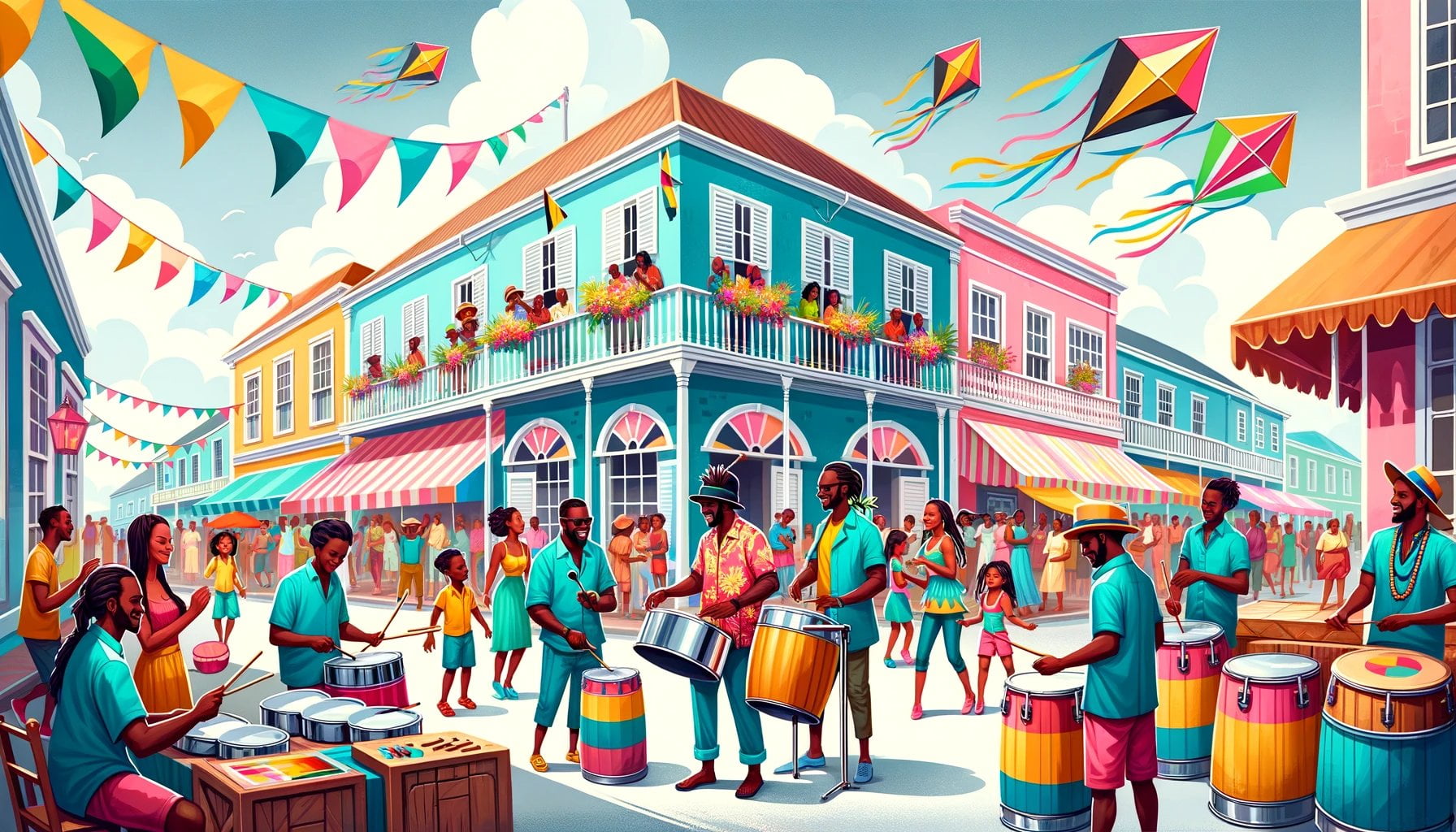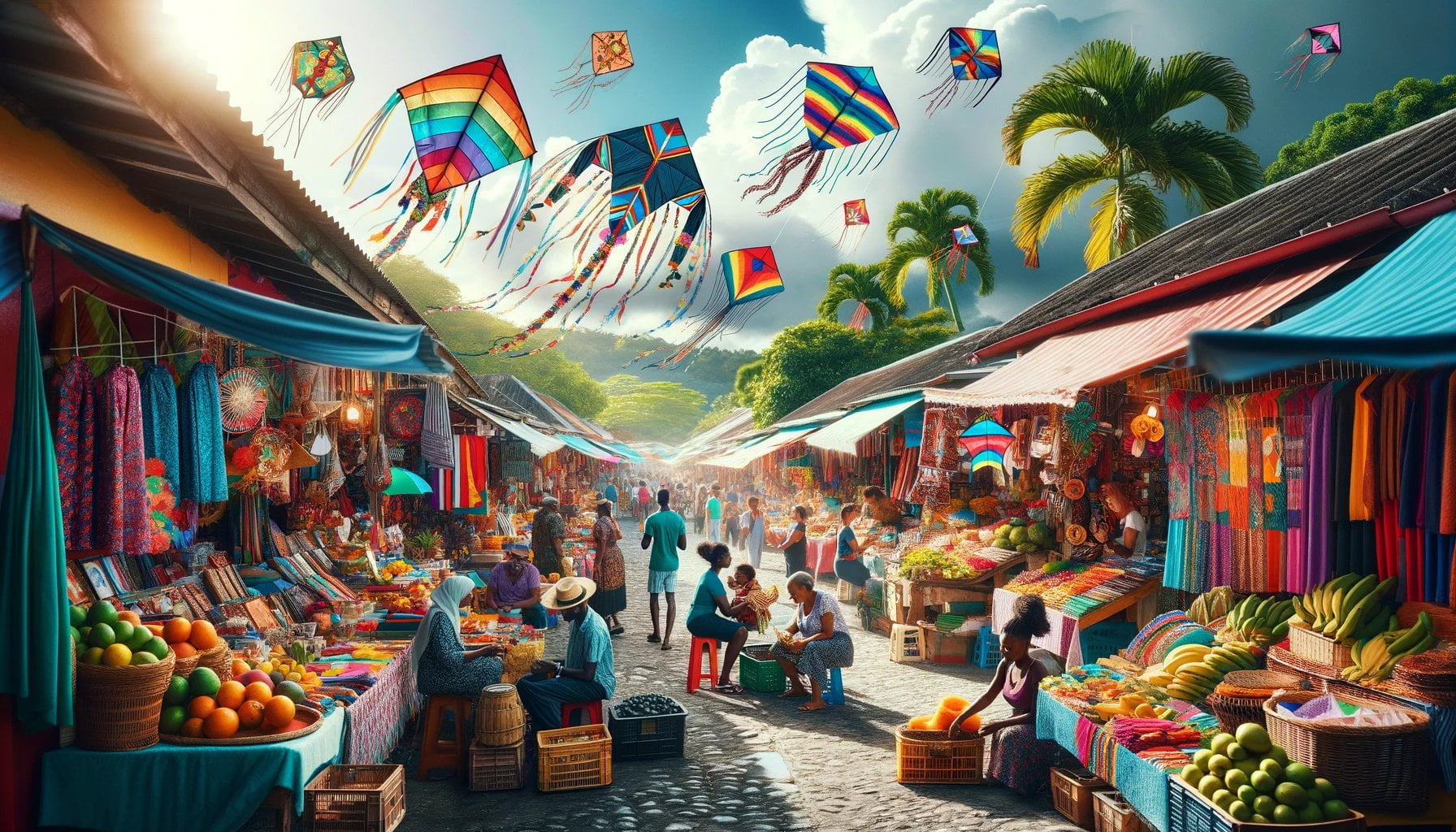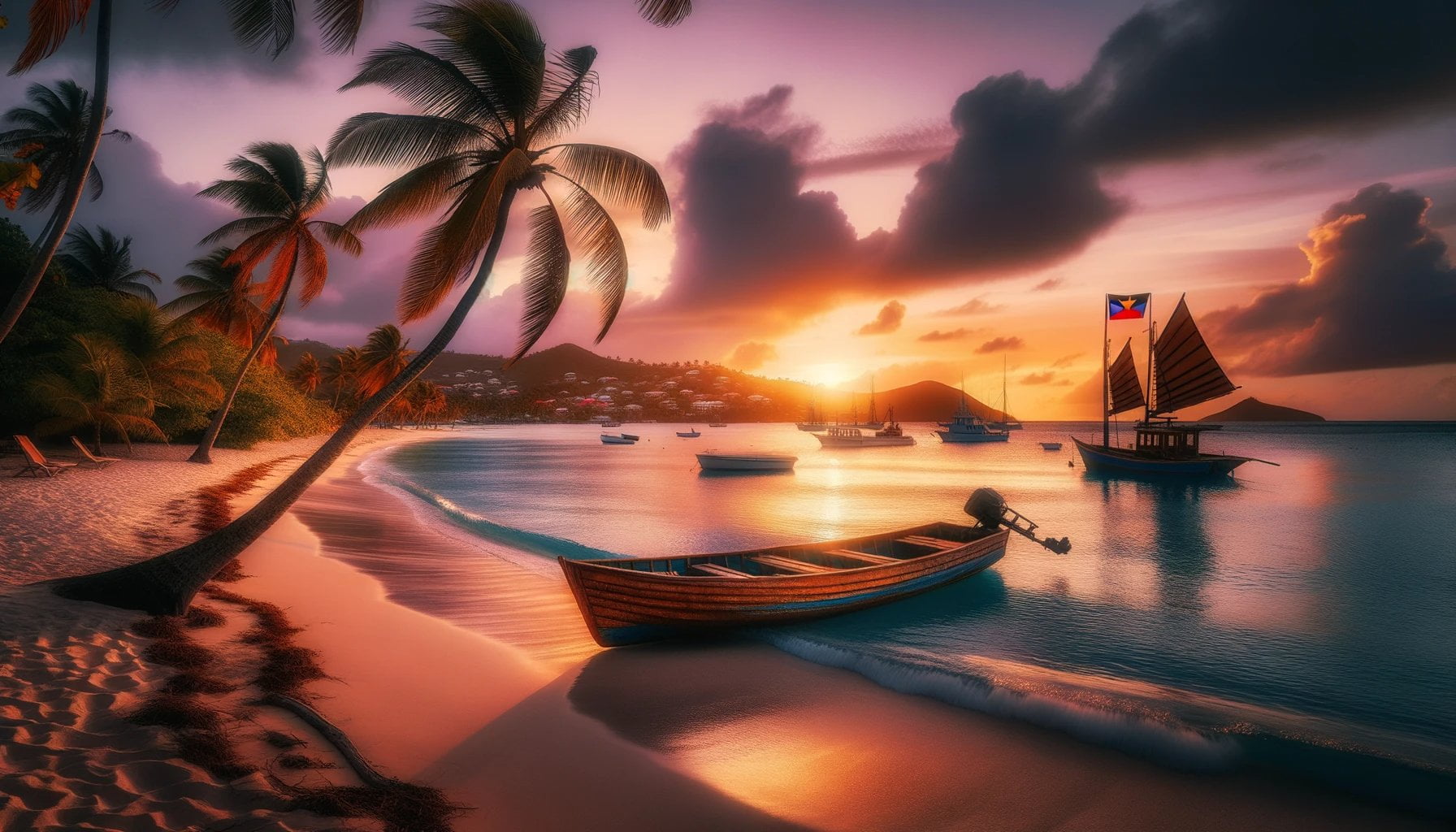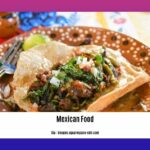Discover the captivating and ever-evolving culture of Antigua and Barbuda as we embark on a vibrant journey through these enchanting Caribbean islands. In this article, titled “Exploring the Dynamic Culture of Antigua and Barbuda,” we delve into the rich tapestry of customs, traditions, cuisine, and history that define this unique destination. As an experienced travel writer and cultural enthusiast, I invite you to join me in unraveling the captivating heritage and distinctive way of life that make Antigua and Barbuda a truly special place to explore.

Key Takeaways:
- The culture of Antigua and Barbuda is a creole culture that emerged from the mixing of Amerindian, West African, and European cultural traditions.
- It is influenced by the islands’ British colonial history, the African heritage of the people, and the Caribbean music and festivals.
- Christianity is the major religion, and calypso music and carnival celebrations are important aspects of the culture.
- The cuisine of Antigua and Barbuda is influenced by African and British traditions, with popular dishes including fungal, seasoned rice, lobster, saltfish, and ducana.
- Sports, particularly cricket and association football, play a significant role in Antiguan and Barbudan culture.
- The culture showcases a rich heritage and is intertwined with various influences, reflecting the diverse history of the islands.
- The impact of British colonialism is evident, as is the African heritage of the people.
- Calypso music and carnival celebrations are integral parts of the culture.
- Overall, the culture of Antigua and Barbuda is vibrant and diverse, with influences from Amerindian, West African, and European traditions.
Antigua and Barbuda Culture
The vibrant and dynamic culture of Antigua and Barbuda is a wonderful fusion of various traditions and influences, creating a unique creole culture that is both intriguing and diverse. This article delves into the rich heritage and customs that define the culture of Antigua and Barbuda, highlighting its significance and offering readers an authentic and engaging glimpse into this culturally-rich destination.
A Blend of Influences
Antigua and Barbuda’s culture is a fascinating amalgamation of Amerindian, West African, and European (primarily British) traditions. The mixing of these cultures has shaped a vibrant creole culture that is an essential part of the country’s identity. From language and cuisine to music and festivals, the culture of Antigua and Barbuda reflects its diverse history.
Language and Cuisine
The language spoken in Antigua and Barbuda is predominantly English, due to the British colonial influence. However, you can still hear the unique Antiguan and Barbudan dialect, infused with elements of African and Caribbean expressions. This linguistic fusion adds a distinctive flavor to the culture.
When it comes to cuisine, Antigua and Barbuda offer a diverse range of dishes that showcase the fusion of African and British culinary traditions. Popular dishes include fungal, which is similar to polenta, seasoned rice, lobster, saltfish, and ducana, a delicious sweet potato pudding. Exploring the local cuisine is a delightful way to immerse oneself in the culture and savor the flavors that have been passed down through generations.
Music, Dance, and Festivals
Music is an integral part of Antiguan and Barbudan culture, with calypso being a genre deeply intertwined with the nation’s history. The powerful rhythms and vibrant melodies of calypso music have their roots in the African slave communities and played a significant role in their communication and cultural expression. Today, calypso music is embraced as a celebration of Antigua and Barbuda’s rich cultural heritage.
Dance is another captivating aspect of the culture, with traditional dances like the Bele and the Dumbbake showcasing the rhythmic and expressive movements passed down through generations. These dances often accompany the lively beats of the steel pans, creating a captivating spectacle that showcases the vivacity of Antiguan and Barbudan culture.
Festivals are an integral part of Antiguan and Barbudan culture, offering a vibrant and lively atmosphere that reflects the spirit of the islands. The most notable festival is the Antigua Carnival, a grand celebration of music, dance, and colorful costumes. This annual event draws both locals and visitors alike, offering an unforgettable immersion into the culture and traditions of Antigua and Barbuda.
Religion and Celebrations
Christianity is the major religion in Antigua and Barbuda, and Christian customs and celebrations hold great significance in the culture. Church services, particularly on Sundays, are an important part of the weekly routine for many residents, offering a sense of community and spiritual fulfillment.
Additionally, the celebration of local produce is another notable aspect of Antiguan and Barbudan culture. Farmers’ markets, such as the bustling Saturday morning market in St. John’s, highlight the abundance of fresh fruits, vegetables, and other local products. This emphasis on local produce not only supports the economy but also showcases the importance of sustainability and the connection to the land.
Sports and Recreation
Sports play an integral role in Antiguan and Barbudan culture, with cricket and association football being the most popular games played by islanders. The nation has a national cricket team and regularly participates in international cricket competitions, reflecting the passion and talent for the sport.
The islands’ natural beauty also lends itself to a variety of recreational activities, such as snorkeling, diving, and sailing. These activities not only provide a source of enjoyment for locals and visitors but also highlight the importance of preserving and appreciating the natural environment.
The Rich Tapestry of Antigua and Barbuda Culture
In conclusion, the culture of Antigua and Barbuda is a captivating tapestry woven from a myriad of influences. The mixing of Amerindian, West African, and European traditions has created a unique creole culture that is characterized by its language, cuisine, music, and festivals. From the vibrant rhythms of calypso to the mouthwatering flavors of local cuisine, Antigua and Barbuda’s culture offers a truly immersive and enriching experience for those who seek to explore its dynamic heritage.
Antigua and Barbuda is a beautiful Caribbean destination with an intriguing history. If you’re looking for some fascinating facts about Antigua and Barbuda, click here to uncover them!
If you’re planning a trip to Antigua and Barbuda, you won’t want to miss out on the vibrant tourism scene. Discover all the incredible things to see and do in Antigua and Barbuda by clicking here.
Delve into the captivating history of Antigua and Barbuda by clicking here. Explore the tales of early settlers, colonial influences, and the fight for independence.
Antigua and Barbuda is home to some truly remarkable places. Click here to discover the famous landmarks and natural wonders that make this Caribbean nation so special.
Indulge your taste buds in the exquisite cuisine of Antigua and Barbuda by clicking here. From fresh seafood to mouthwatering desserts, the flavors of this island paradise are unforgettable.
Rich History and Colonial Influences
The culture of Antigua and Barbuda is deeply intertwined with its rich history and colonial past. The islands have a fascinating heritage that reflects the influences of African traditions and British colonization.
Colonial Legacy and Independence
Antigua and Barbuda have a captivating historical narrative shaped by the arrival of Christopher Columbus in 1493 and subsequent colonization by English settlers in 1632. The islands remained under British possession, but they faced challenges along the way, including a French raid in 1666. Finally, Antigua and Barbuda gained independence in 1981, marking a significant milestone in their history.
Blend of African Heritage
The majority of people in Antigua and Barbuda are descendants of African slaves who were brought to the islands to work on sugar cane plantations. This African heritage has left a lasting impact on the culture, from the language spoken to the traditions and customs celebrated.
British Colonial Influences
During the period of British colonization, the islands inherited cultural elements from their colonial rulers. This influence is evident in various aspects of Antiguan and Barbudan culture, including language, cuisine, and governance. While English is the predominant language spoken, the local dialect adds a distinctive flavor to conversations.
Traditional Cuisine
Antigua and Barbuda’s cuisine is a delightful fusion of African and British culinary traditions. Local dishes such as fungie (cornmeal), seasoned rice, lobster, saltfish, and ducana (sweet potato pudding or dumplings) showcase this unique blend. Indulging in local confectioneries like peanut brittle, tamarind, raspberry stew, and sugarcake provides a tantalizing taste of the islands’ flavors.
Cultural Expressions
The culture of Antigua and Barbuda finds its voice in various artistic and creative expressions. Traditional dances like Bele and Dumbbake, accompanied by the vibrant sounds of steel pans, showcase the islands’ rich musical heritage. Festivals, notably the Antigua Carnival, bring the community together in vibrant celebrations of music, dance, and elaborate costumes.
Historical Significance
Immersing oneself in Antigua and Barbuda’s history is like stepping into a living museum. The historical sites and landmarks scattered across the islands tell stories of the struggles and triumphs of the past. Exploring places like Nelson’s Dockyard and Betty’s Hope Plantation provides insight into the colonial era and its lasting impact on the islands’ culture.
Modern Influences
As with any culture, Antigua and Barbuda’s way of life has evolved over time. While rooted in a rich history, the islands have embraced modern influences that shape their present cultural landscape. The blending of traditional and contemporary elements creates a dynamic and vibrant culture.
Key Takeaways:
– The culture of Antigua and Barbuda is enriched by its rich history and colonial influences.
– African traditions blend with British colonial legacies to shape the islands’ unique cultural heritage.
– Local cuisine combines African and British culinary traditions, tantalizing the taste buds.
– Traditional dances and festivals showcase the vibrant music and dance culture of the islands.
– Exploring historical sites offers a glimpse into the colonial past and its significance.
– Modern influences have contributed to the dynamic and ever-evolving culture of Antigua and Barbuda.
Sources:
– iExplore. “Antigua and Barbuda — History and Culture”
– WorldAtlas. “The Culture Of Antigua And Barbuda”
Vibrant Music, Dance, and Festivals
Antigua and Barbuda come alive with vibrant music, electrifying dance, and captivating festivals that showcase the unique cultural tapestry of these islands. From rhythmic beats to colorful costumes, the rich heritage of Antigua and Barbuda is best experienced through its lively music, dynamic dance forms, and exciting festivals.
Music: The Heartbeat of Antigua and Barbuda
In Antigua and Barbuda, music flows through the veins of the people. Influenced by African rhythms, British colonial history, and modern influences, the island’s music scene is a vibrant fusion of sounds and styles. The two dominant genres are calypso and soca music, which have deep roots in the local culture.
Calypso music, characterized by its infectious melodies and witty storytelling lyrics, has been a significant part of Antiguan and Barbudan history for centuries. This genre, born during the days of slavery, served as a means of cultural expression and social commentary for the enslaved population. Today, calypso music continues to captivate audiences with its infectious rhythms and thought-provoking lyrics.
Soca music, a more recent addition to the music scene, blends elements of calypso, funk, and soul. Known for its energetic beats and captivating melodies, soca music has become the life of many parties and festivals in Antigua and Barbuda. Its lively sound ensures that dancing is always the order of the day.
Dance: A Rhythmical Expression
Dance is an integral part of the vibrant cultural landscape of Antigua and Barbuda, serving as a rhythmic expression of the island’s history and traditions. Traditional dances like the Bele and Dumbbake are accompanied by upbeat music and are performed during festivals and celebrations.
The Bele dance, influenced by African and French traditions, is characterized by synchronized movements, intricate footwork, and vibrant costumes. This dance form showcases the resilience and spirit of the African heritage deeply embedded in Antiguan and Barbudan culture.
The Dumbbake dance, on the other hand, is a lively group dance where participants form a circle and follow rhythmic patterns. Accompanied by the joyful beats of steel pans, this dance radiates energy and unity, bringing people together in celebration.
Festivals: Celebrating Life and Culture
Festivals are an essential aspect of the local culture, offering a glimpse into the dynamic spirit and traditions of Antigua and Barbuda. The islands’ calendar overflows with exciting festivals that celebrate music, dance, and the vibrant way of life.
Antigua Carnival steals the show as the most anticipated festival, lasting for ten days each year. This colorful extravaganza commemorates the anniversary of the end of slavery on the islands and is a dazzling display of vibrant costumes, pulsating rhythms, and exuberant parades. The air is filled with the sounds of calypso music, igniting the spirit of celebration in everyone.
Other festivals in Antigua and Barbuda include the Antigua Sailing Week, where the island’s nautical heritage and love for sailing are showcased, and the Antigua Roots Festival, which celebrates the African roots of the people through music, dance, and cultural performances.
The Food and Drink Festival tantalizes the taste buds with a plethora of flavors, featuring local delicacies and culinary delights. This festival not only highlights the mouthwatering dishes of Antiguan and Barbudan cuisine but also immerses visitors in the cultural significance of food and its role in community celebrations.
Key Takeaways:
- Antigua and Barbuda’s vibrant culture is influenced by African heritage, British colonial history, and modern influences.
- Calypso and soca music are vital components of the islands’ musical landscape, reflecting their rich history and cultural expressions.
- Traditional dances such as Bele and Dumbbake showcase the rhythmic and diverse dance forms of Antigua and Barbuda.
- Festivals like Antigua Carnival, Antigua Sailing Week, the Food and Drink Festival, and the Antigua Roots Festival are vibrant celebrations that highlight the dynamic spirit and traditions of the islands.
Culinary Traditions and Local Cuisine: A Fusion of Flavors
Antigua and Barbuda’s culinary traditions reflect the rich multicultural heritage of the islands. Influenced by indigenous, African, and British cultures, the local cuisine is a delightful fusion of flavors that will tantalize your taste buds.
Influences from Around the World
Centuries of cultural exchange have shaped the culinary landscape of Antigua and Barbuda. The indigenous people of the islands introduced their unique flavors, which later intertwined with the culinary practices of African slaves. British colonization added another layer of influence, bringing British ingredients and cooking techniques to the islands.
Local Delicacies
Let’s embark on a culinary journey and explore some of the traditional dishes that highlight the vibrant flavors of Antigua and Barbuda:
- Saltfish: A staple in many households, saltfish is preserved cod soaked or boiled to remove the salt. It is then cooked with onions, tomatoes, garlic, and other vegetables, creating a flavorful and comforting dish.
- Fungie and Pepperpot: Considered the national dish, fungie is similar to Italian polenta and is primarily made with cornmeal. It is often served alongside pepperpot, a rich and savory stew made with meat and a variety of vegetables.
- Ducana: This traditional sweet treat is made from grated sweet potatoes, coconut, sugar, and spices, all wrapped in banana leaves and boiled or steamed. It is often enjoyed as a dessert or snack.
- Johnny Cakes: These deep-fried balls of goodness are crunchy on the outside and soft on the inside. They are usually served with meaty accompaniments like saltfish or stewed meats.
- Black Pudding: Also known as rice pudding, this dish is a savory sausage made with blood, special herbs, and spices. It can also contain rice and/or potatoes for added texture.
- Goat Water: Described as a well-seasoned, meat-rich soup, goat water is a popular dish in the Caribbean region, including Antigua and Barbuda. It features a light broth and tender pieces of goat meat.
Culinary Diversity
Antigua and Barbuda’s cuisine is a testament to the multicultural nature of the islands. Flavors and ingredients from Asia, India, Syria, and various Caribbean countries blend together to create a unique and vibrant food scene. From spicy curries to fresh seafood delicacies, there is something to satisfy every palate.
Key Takeaways:
- Antigua and Barbuda’s traditional cuisine is a fusion of indigenous, African, and British influences.
- Seafood, including lobster, fish, and conch, takes center stage in many local dishes.
- Local delicacies like saltfish, fungie and pepperpot, ducana, johnny cakes, black pudding, and goat water highlight the diverse flavors of the islands.
- Antigua and Barbuda’s culinary traditions are shaped by centuries of cultural exchange and reflect the multicultural nature of the islands.
- The cuisine incorporates flavors from West Africa, China, India, Syria, Lebanon, Jamaica, Spain, and Great Britain.
Sources:
– Chef’s Pencil: Top 10 Traditional Foods in Antigua & Barbuda
– Visit Antigua & Barbuda: Traditional Cuisine

FAQ
Q1: What is the cultural heritage of Antigua and Barbuda?
A1: The cultural heritage of Antigua and Barbuda is a unique blend of Amerindian, West African, and European traditions, resulting in a creole culture. The islands’ British colonial history, African heritage, and Caribbean music and festivals all contribute to the vibrant cultural tapestry of the country.
Q2: What is the traditional cuisine of Antigua and Barbuda?
A2: The traditional cuisine of Antigua and Barbuda is a fusion of indigenous, African, and British influences. Some popular dishes include saltfish, fungie and pepperpot, ducana, Johnny cakes, black pudding, and goat water. The multicultural nature of the islands is reflected in the diverse flavors and ingredients used in local dishes.
Q3: What are some popular festivals in Antigua and Barbuda?
A3: Antigua and Barbuda is known for its vibrant festivals. Some popular ones include Antigua Sailing Week, Antigua Carnival, the Food and Drink Festival, and the Antigua Roots Festival. These festivals showcase the cultural diversity of the islands and feature vibrant costumes, parades, music, and traditional dances.
Q4: What role do sports play in Antiguan and Barbudan culture?
A4: Sports, particularly cricket and association football, play a significant role in Antiguan and Barbudan culture. The country has a national cricket team and participates in international cricket competitions. The love for sports unites the community and provides a sense of pride and identity.
Q5: How is the culinary scene in Antigua and Barbuda influenced?
A5: The culinary scene in Antigua and Barbuda is influenced by centuries of cultural exchange. The indigenous people, African slaves, and British colonizers all contributed to the flavors and cooking techniques used in local dishes. Additionally, the islands’ diverse population and influences from other Caribbean and international cuisines add to the culinary diversity of Antigua and Barbuda.
















